On a trip to see family in Seattle this past August, I visited the National Nordic Museum and stumbled into a special exhibit on landscapes by Finnish painters. I don’t know if it was the luxury of visiting an art gallery for the first time in nearly two years – my soul starved for art not on a screen — or if it was the sheer novelty of an unexpected burst of free time, while my son was occupied with grandparents — but I felt the most extraordinary joy viewing this gallery and taking in every image.
I had no prior familiarity with these Finnish painters (or any Finnish painters, really). The one painting I kept circling back to was called “Wild Anjelica,” by an artist named Akseli Gallen-Kallela (1865-1931). This painting was created in 1889, but the colors seemed so fresh and vibrant, the paint still looked wet, the canvas vibrated with energy.
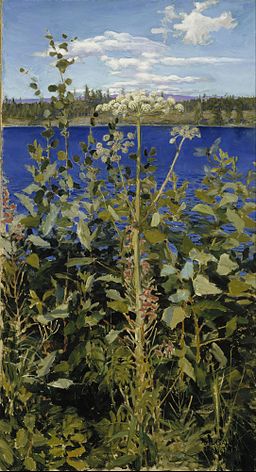
“Wild Anjelica” by Akseli Gallen-Kallela
I have become obsessed with this painting, often gazing at it on screens since my return home. It is a strange image to fixate on in some ways. Its subject is not a grand tree, or a conventionally picturesque flower. Wikipedia generously calls wild anjelica a “species of flowering plant.” But if I didn’t know better, I might call it a WEED. The central image of a rather scrubby-looking blossom, surrounded by prickly neighbors, looks like a plant right out of my own yard, which is tangled with all kinds of weeds that by late summer I typically give up trying to tame. It’s edible, a form of wild celery, and a distant relative of the carrot. But it’s not something I’m dying to sprinkle on a salad.
I think what draws me to this image is its unconventional beauty, and the strength it exudes. I equate Wild Anjelica, and this painting, with these pandemic times. I think of how amidst sickness and suffering and anxiety, we can find beauty in resilience. Like this plant, we twist our lives to find space and light, living in less than perfect conditions. Like this plant, we announce, in defiance: We are here. We are here.
Or maybe this plant and its neighbors are akin to the pandemic. Ugly, dense, no clear way out. Invasive. The alluring blue of water and sky feel like the life we left behind – or the hope of better times to come, on the other side of this virus.
Yet there’s energy and strange beauty in the weeds, just as there are in these times. I reflect on how I have connected creatively with family and friends for over 18 months. I’ve joined my mother on the other side of the country in dance classes online and at the “opera” every Friday night (sung by her neighbor two blocks away, and live-streamed on Facebook). My family acquired a dog. We’ve dined out, on occasion, in parking lots. We’ve tirelessly (or tiredly) Zoomed. I had a milestone birthday, which I feel lucky and privileged to celebrate. We’ve found ways to live creatively, defiantly. Our life probably isn’t the distant water. It’s probably the thicket of weeds.
I like how Gallen-Kallela seems to be playing with us. Are we meant to look at this weedy flower demanding attention in the center of the frame? Or does our eye want to shift to the impossible blue of that water behind it, or up to that expansive sky? The neighboring weeds, too, clamor for attention, insist on being seen and admired, stretching as if to block the water from view.
Sometimes I wonder if the plants in this painting can even be called weeds. They’re not stifling the growth of more carefully cultivated plants. They’re the only plants in the painting.
This painting has also made me appreciate the weeds I’m not pulling in my own yard. I can see them as plants that happen to live in my area, that predate my house and scoff at my landscaping, that have flourished in a summer of heavy rains. I also appreciate the time I’m not spending in battle with them. These days, in my yard, I just live with them. On my walks, I let the wild plants brush my legs. Here are some I pass every morning on my walk with my dog. I’ve come to know and even admire them: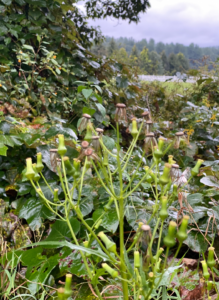
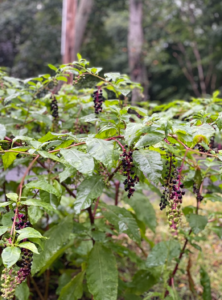
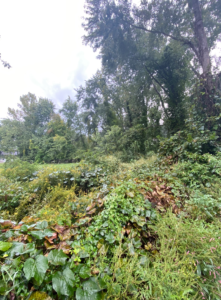
“Wild Anjelica” makes me reflect on my writing process, too. I love the revision stage of writing best because it feels like weeding. The work is hard, sometimes grueling, but satisfying, bringing clarity and lightness. I am a ruthless reviser, cutting out unnecessary scenes and plot lines, or even eliminating characters.
The hardest part of writing for me is shifting from polishing a book to embarking on something new. Tolerating the messiness, the sprawling plot lines and willful characters that threaten to destroy my careful planning, climbing over my path and over the fence rails.
The project I’m working on now has a very new shape for me — it’s a verse novel — and it continually surprises me. New voices clamor to be heard when I thought I had only two narrators. My careful dual timeline structure wants to go in new directions. Backstory creeps in at every turn.
“Wild Anjelica,” and the “weeds” along my walks, are ultimately teaching me patience. I am learning to see the process of drafting, especially in this new-to-me form, not as messiness, but as wildness. I am trying to be more playful, and not worry so much yet about whether some parts are getting in the way of the story, or whether they are the story itself. I am not plotting and planning this project in the same way I have organized my previous novels. Maybe some parts of this particular story are demanding my attention for a reason. Maybe some voices want to be heard. My challenge to myself as I embark on this very early draft is to resist that urge to weed. I will make some space for surprises, and pay attention, as I learn to write — and live — in a new form.
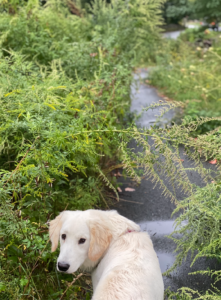
My dog, however, feels a little less happy about the weeds in his path.